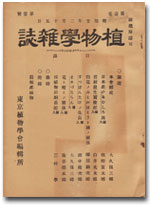All issues

Volume 80, Issue 943
Displaying 1-6 of 6 articles from this issue
- |<
- <
- 1
- >
- >|
-
Tamotsu OOTAKI1967 Volume 80 Issue 943 Pages 1-10
Published: 1967
Released on J-STAGE: October 31, 2006
JOURNAL FREE ACCESSThe developmental patterns of the fern protonema of Pteris vittata and regeneration patterns of isolated single cells, which were cultured under various light conditions, were investigated.
Branchings were induced when the 5-cell stage protonemata, which were germinated under 700lux white light, were transferred to 3, 000lux white light, or replaced to the former condition after transferring to continuous blue light, red light, or darkness. When the protonema grown in white light was cut to the component cells, each cell regenerated mainly from its anterior region. Intra- and intercellular gradients were observed in regeneration patterns. These gradients disappeared in the protonemata transferred to 3, 000lux white light, blue, red, or dark conditions.
Regeneration time was shorter in the cells which were isolated from the gametophytes transferred to blue or 3, 000lux white light, and longer in the cells which were isolated from the protonemata kept in darkness or red. The original apical cell, isolated from the branched protonema which had already ceased the growth, required a long time for regeneration, and initiated regeneration from the posterior or the middle regions of that cell.
These results show that branching seems to depend on the disappearance of apicobasal gradient of physiological activity to which polar regeneration patterns are owing.View full abstractDownload PDF (1463K) -
Ichiroku HAYASHI, Makoto NUMATA1967 Volume 80 Issue 943 Pages 11-22
Published: 1967
Released on J-STAGE: October 31, 2006
JOURNAL FREE ACCESSAutecological studies were carried out about 14 important species which constitute the early stage of subsere. The comparative study of their germination behaviour is an attempt to account for the mechanism of plant succession in Kanto district, central Japan. The seed of Ambrosia elatior, Erigeron annuus, Chenopodium album var. centrorubrum, etc. were incubated under different light-temperature regimes, after preservation under three distinct conditions: 1) under room temperature, 2) stratification at 0-3°, 3) buried in the field soil. The weight of seed and their dissemination type of these species were examined, too. The seed of the pioneer species such as Ambrosia elatior, Setaria viridis and Polygonum nodosum are heavy, and the germination is characterized by: 1) slow progression of after-ripening, 2) acceleration of it by stratification at 0-3°or burying in the field. In the contrast with them, Erigeron annuus and E. sumatrensis which replace the pioneer species and become dominant of the community with the progress of succession, have light seed and high germination rate even in a younger age of after-ripening. Also they show no effect on the germination rate after stratification or burying treatment in the field soil. The characters necessary for the pioneer species in the first year are discussed based on the results mentioned above.View full abstractDownload PDF (1352K) -
Cytochrome f from Tobacco LeavesRuri HOTTA, Seki SHIMIZU, Einosuke TAMAKI1967 Volume 80 Issue 943 Pages 23-26
Published: 1967
Released on J-STAGE: October 31, 2006
JOURNAL FREE ACCESSIn order to investigate the photosynthetic activity of tobacco plants with special reference to the relationship between this activity and the content of cytochrome f, the method of extraction and some properties of this compound was studied.
Cytochrome f was extracted from tobacco chloroplasts, using ammoniac ethanol solution containing Triton X-100. Tobacco cytochrome f had properties similar to those of parsley cytochrome f.
The concentration of cytochrome f in the extract was 0.18 to 0.2μmoles and not affected by the variety of tobacco plants. As the concentration of chlorophyll of tobacco plants varied remarkably among the varieties, the ratio of chlorophyll/cytochrome f differed due to the difference of the starting materials.View full abstractDownload PDF (411K) -
Yukiyoshi OGAWA1967 Volume 80 Issue 943 Pages 27-32
Published: 1967
Released on J-STAGE: October 31, 2006
JOURNAL FREE ACCESSRelative effectiveness of gibberellins A1-A9 except for A6, allogibberic acid, gibberic acid, epiallogibberic acid, kaurenoic acid and mevalonic acid on the leaf sheath elongation of rice seedling and on the release of reducing sugars from rice endosperm and the producing activity of amylases in rice endosperm was examined.
The order of effectiveness in the rice seedling test was A3>A1>A7>A2>A5>A4>A9>allogibberic acid>A8>gibberic acid=epiallogibberic acid=kaurenoic acid=mevalonic acid=water control.
The order of effectiveness in the rice endosperm test was A1_??_A3_??_A4_??_A7> A2>A5>A9>A8>allogibberic acid>gibberic acid=epiallogibberic acid=kaurenoic acid=mevalonic acid=water control.
The discordance in the order for the leaf sheath elongation and for the enzyme producing activity in the endosperm of the same variety shows that the response is different with respect to the different parts of tissues in the same species.View full abstractDownload PDF (543K) -
Akira YUASA1967 Volume 80 Issue 943 Pages 33-47
Published: 1967
Released on J-STAGE: October 31, 2006
JOURNAL FREE ACCESSDownload PDF (3487K) -
[in Japanese]1967 Volume 80 Issue 943 Pages 54
Published: 1967
Released on J-STAGE: October 31, 2006
JOURNAL FREE ACCESSDownload PDF (237K)
- |<
- <
- 1
- >
- >|